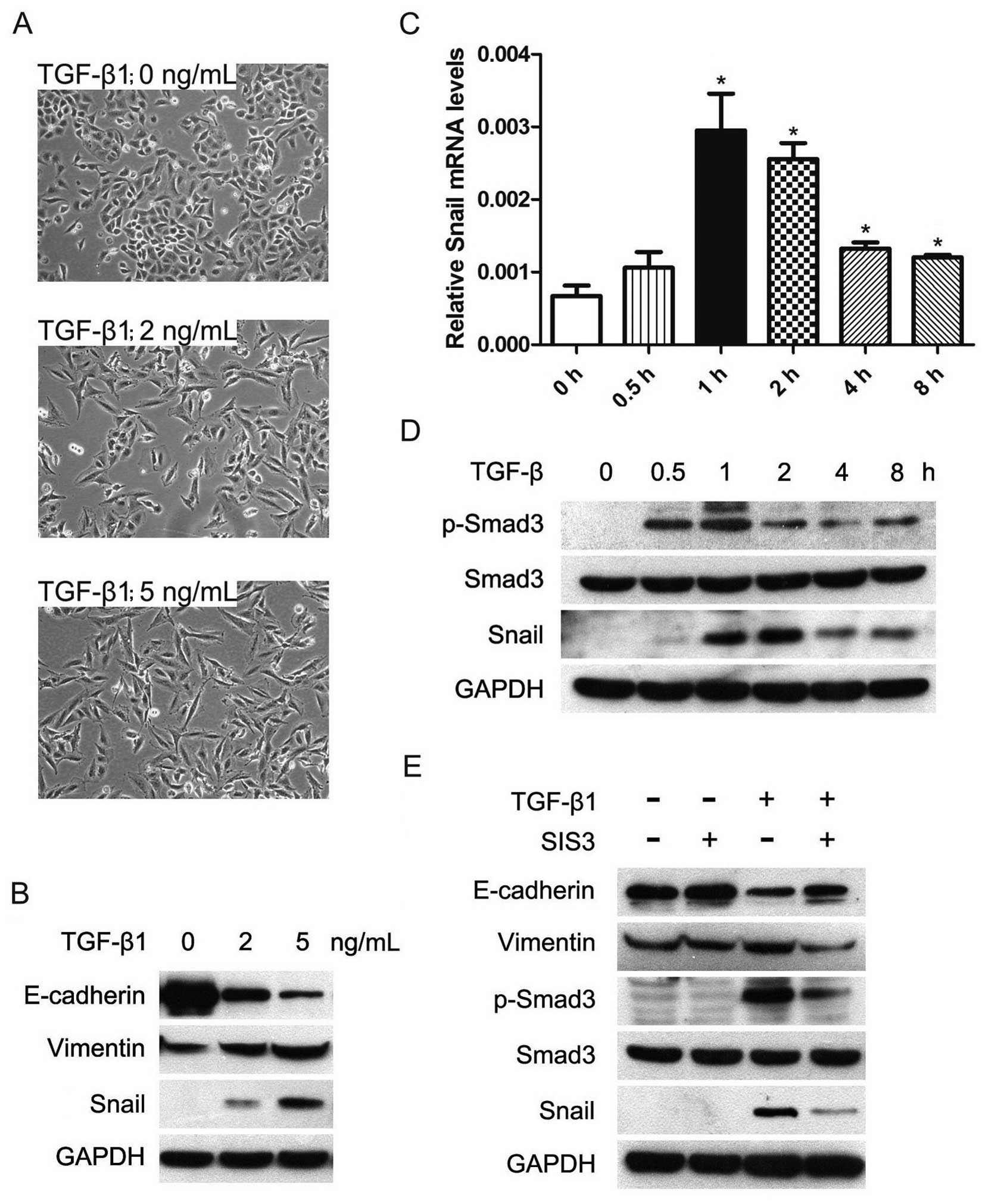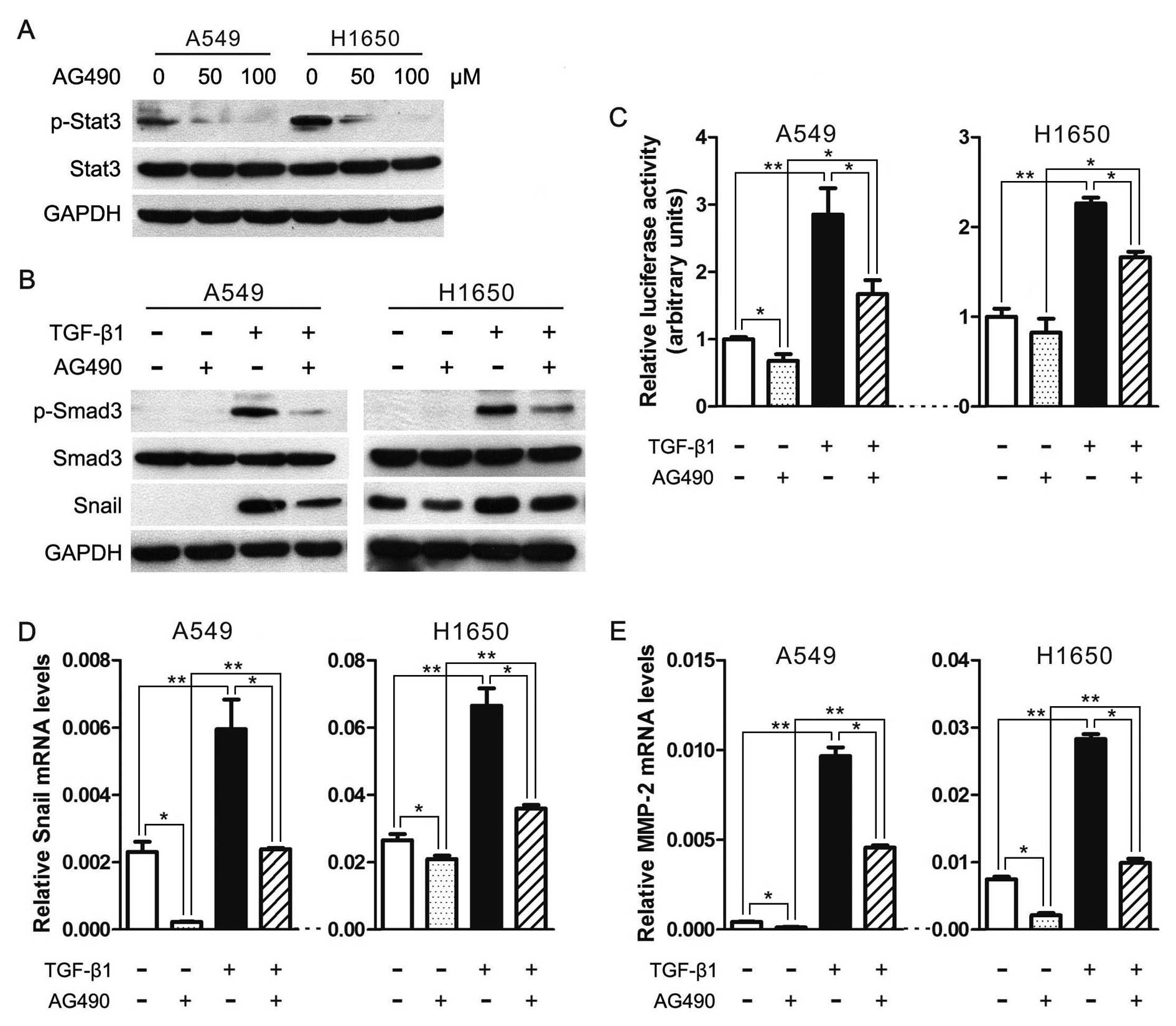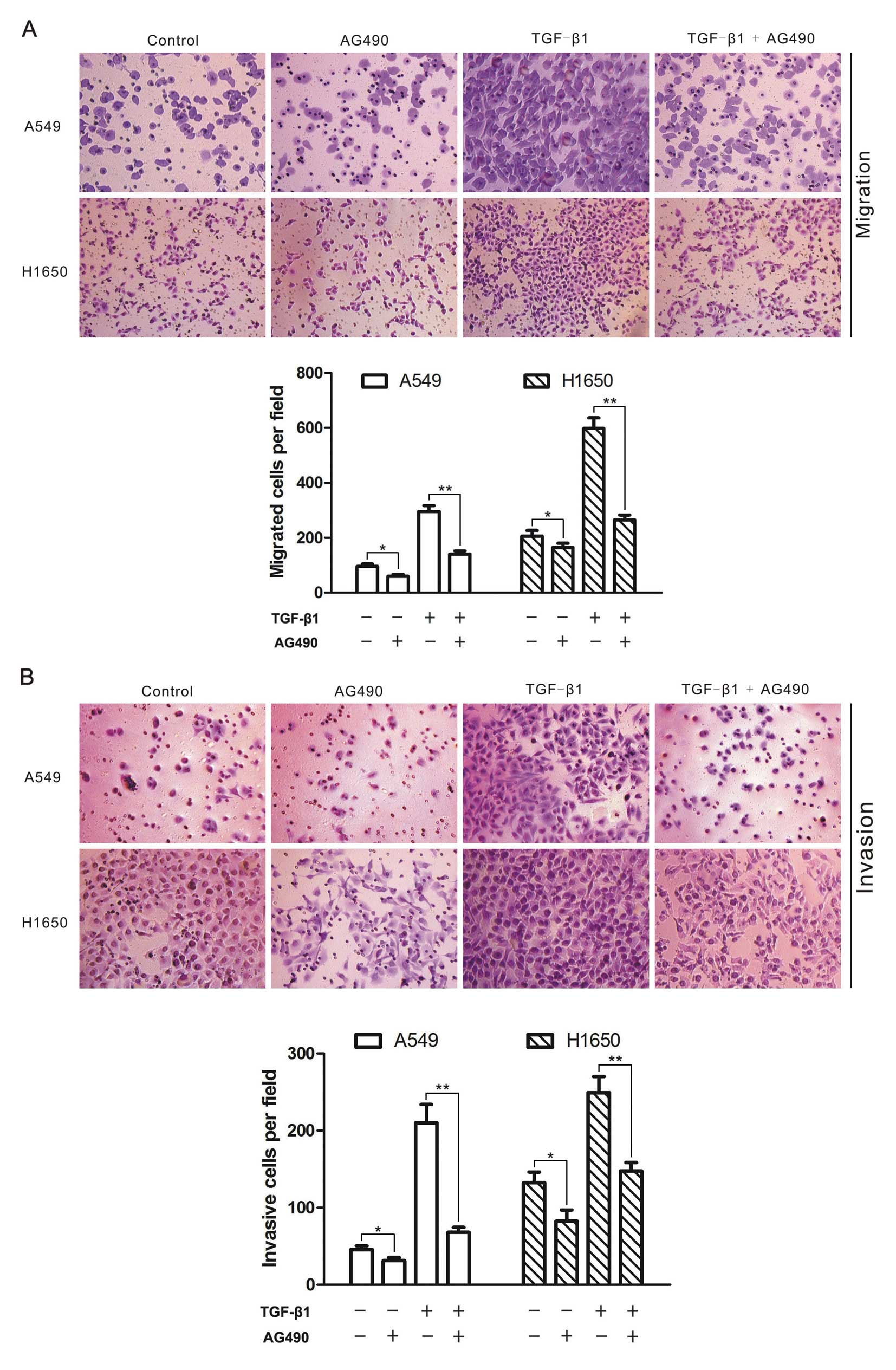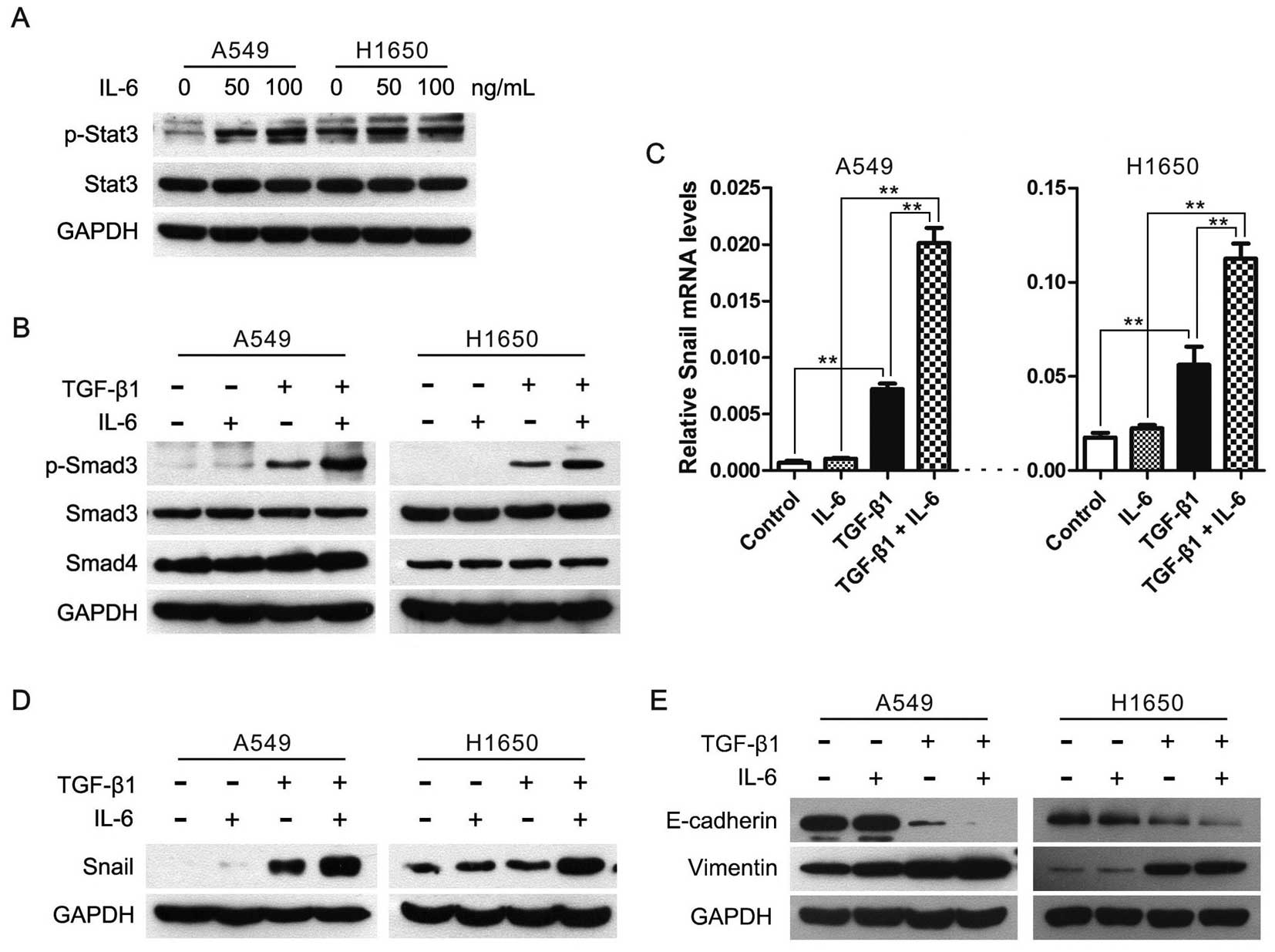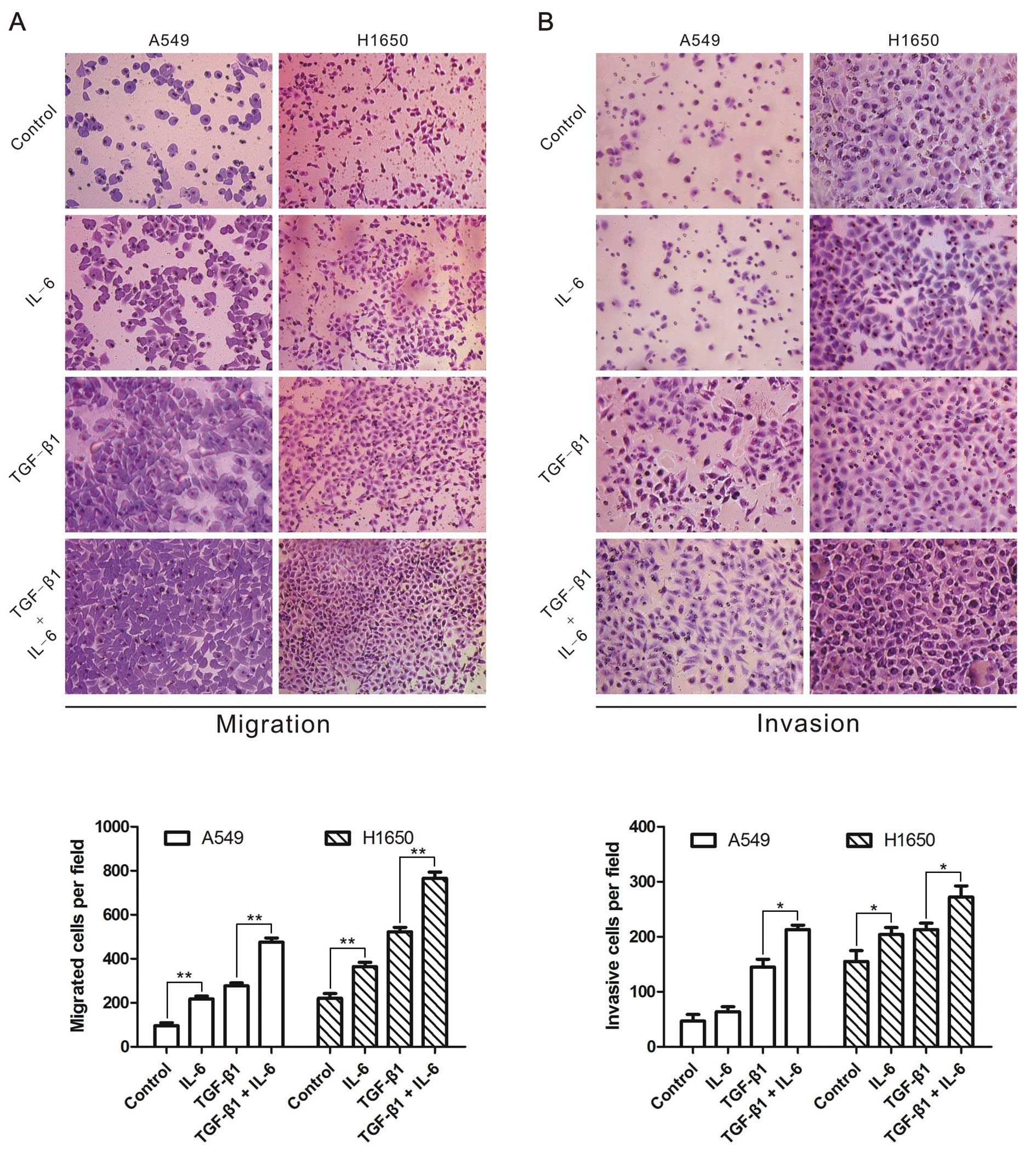JAK/STAT3 signaling is required for TGF-β-induced epithelial-mesenchymal transition in lung cancer cells
- Authors:
- Published online on: February 21, 2014 https://doi.org/10.3892/ijo.2014.2310
- Pages: 1643-1651
Abstract
Introduction
Lung cancer is the leading cause of cancer death worldwide. In fact, over 90% of deaths from solid tumors, including lung cancer, is mainly due to cancer metastasis (1). Metastasis of tumor cells is associated with epithelial-mesenchymal transition (EMT), which is a process whereby epithelial cells acquire new features of mesenchyme (2).
EMT is vital for the conversion of early-stage tumors into invasive malignancies (3). Alterations in morphology, cellular architecture, adhesion, and migration capacity are required for EMT (4). As one of the hallmarks of EMT, the functional loss of E-cadherin is currently thought to promote invasion during carcinoma progression (5). The E-cadherin repressors, in particular, Snail can be induced by a number of distinct signaling pathways, such as TGF-β, Wnt and Notch (6–8).
TGF-β signaling is a primary inducer of EMT in various cancers, including lung cancer (9–11). TGF-β binding to its receptors leads to phosphorylation of Smad2 and Smad3, which partner with Smad4 and then translocate into the nucleus where Smad transcriptional complexes control the expression of target genes, including Snail (8,12). Importantly, Smad3 and Smad4 rather than Smad2 played an essential role in TGF-β-induced Snail expression and EMT (9,13–15).
Interleukin-6 (IL-6)-mediated aberrant activation of Janus kinases/signal transducer and activator of transcription 3 (JAK/STAT3) signaling is frequently presented in human cancer including lung cancer and implicated in transformation, tumorigenicity, EMT and metastasis (16–20). Additionally, inhibition of JAK2 tyrosine kinase or blockade of activated Stat3 significantly suppressed the EMT process, cancer cell migration and invasion in vitro, and attenuated cancer cell metastasis in vivo (21–23). Although no association of JAK/STAT3 signaling with EMT of lung cancer is so far well established, elevated level of serum IL-6 has been observed in lung cancer patients when compared with normal donors and correlates with advanced lung cancer stage and an overall poor prognosis (24,25), suggesting that the IL-6/JAK/STAT3 pathway may participate in the progression of lung cancer via EMT.
Recent studies have demonstrated that TGF-β-mediated cancer metastasis initiation was associated with the activation of JAK/STAT3 pathway in colorectal cancer (26). Taken together, we hypothesized that IL-6/JAK/STAT3 signaling is required for TGF-β-mediated EMT in lung cancer.
Materials and methods
Cell culture
Human lung cell lines A549 and H1650 were purchased from Cell Bank of Chinese Academy of Science. Cells were cultured in Roswell Park Memorial Institute (RPMI)-1640 medium (Hyclone) with 50 U/ml each of penicillin and streptomycin and 10% heat-inactivated fetal bovine serum (FBS, Invitrogen) in humidified incubators at the condition of 37°C and 5% CO2.
Reagents and antibodies
Human recombinant TGF-β1 and IL-6 were obtained from R&D Systems Inc. (Minneapolis, MN, USA). TGF-β1 was diluted in sterile 4 mM HCl containing 1 mg/ml human serum albumin (HSA); IL-6 was reconstituted in sterile PBS containing 0.1% HSA. JAK2 inhibitor AG490 and Smad3 phosphorylation inhibitor SIS3 were purchased from Merck KGaA (Darmstadt, Germany) and Santa Cruz Biotechnology (Santa Cruz, CA, USA), respectively. Antibodies used for western blotting were mouse anti-E-cadherin (1:3,000, BD Biosciences), mouse anti-vimentin (1:4,000, BD Biosciences), rabbit anti-Snail (1:1,000, Cell Signaling), rabbit anti-Smad3 (1:1,000, Cell Signaling), rabbit anti-phospho-Smad3 (Ser423/425, 1:1,000, Cell Signaling), rabbit anti-Stat3 (1:1,000, Cell Signaling), rabbit anti-phospho-Stat3 (Tyr705, 1:1,000, Cell Signaling), mouse anti-GAPDH (1:3,000, Abcam).
Western blot analysis
Western blot analysis was performed according to the protocol described by us (27) with some modifications. Briefly, cells were lysed in a RIPA buffer with protease inhibitor cocktail (Sigma-Aldrich) and phosphatase inhibitor cocktail (Sigma-Aldrich), and then clarified by centrifugation. Total cell lysates were resuspended in SDS sample buffer and resolved by SDS-PAGE. Proteins were transferred to nitrocellulose membrane (Millipore, Bedford, MA, USA) and then blocked with 5% BSA/TBST buffer for 1 h at room temperature. Membranes were incubated with primary antibodies overnight before incubation with the corresponding HRP-conjugated secondary antibodies and detected using the SuperSignal West Pico Chemiluminescent Substrate (Thermo Fisher Scientific Inc.). All experiments were performed in triplicate.
RNA extraction and quantitative real-time PCR (qRT-PCR)
Cells were grown to 80% confluence on 6-well plates and subjected to RNA extraction using 1.0 ml RNAiso Plus (Takara) according to the manufacturer’s instructions. Synthesis of cDNA with reverse transcriptase was performed by M-MLV First Strand kit (Invitrogen). cDNA aliquots were subjected to qRT-PCR reactions using the Platinum®SYBR®Green qPCRsupermix-UDG with ROX (Invitrogen) on ABI PRISM 7500 Sequence Detection System (Applied Biosystems). Primers used for qRT-PCR were as follows: 5′-CGAAAGGCCTTCA ACTGCAAAT-3′ (forward) and 5′-ACTGGTACTTCTTGA CATCTG-3′ (reverse) for Snail; and 5′-TGCACCACCAACTG CTTAGC-3′ (forward) and 5′-GGCATGGACTGTGGTCAT GAG-3′ (reverse) for GAPDH. The PCR program was 50°C for 2 min, 95°C for 10 min, followed by 40 cycles of 95°C for 15 sec and 60°C for 1 min. A standard melting-curve analysis was carried out at the end of the amplification. Each qRT-PCR experiment was done in triplicates. All the mRNA expression values were normalized to an internal control GAPDH.
Luciferase reporter gene construct
The promoter region of PAI-1, −960 to +124, was amplified by PCR with primers (forward: CGGGGTACCGCACACCCTGCAAACCTGCC and reverse: CCGCTCGAGCGATTGGCGGTTCGTCCTG, containing a KpnI site and a XhoI site, respectively). After digestion with KpnI and XhoI, the resultant fragments were directly ligated into the pGL3-basic luciferase vector (Promega). Before transfection, the sequence of plasmid construct was confirmed by direct sequencing.
Transient transfection and reporter gene assays
Cells were co-transfected with 800 ng pgl3-basic constructs with PAI-1 promoter and 16 ng SV-40 plasmid (as a normalizing control) using Lipofectamine 2000 (Invitrogen). Four hours later, the cells were treated with or without 50 μM AG490 and then incubated for 18 h in the presence or absence of 5 ng/ml TGF-β1. Finally, luciferase activity of the transfected cells was determined using the Dual-Luciferase Reporter Assay System (Promega) on a TD20/20 Luminometer (Turner Designs, Sunnyvale, CA, USA). Three independent transfection experiments were carried out, and each was done in triplicate. Results are reported as relative luciferase activities, which are obtained by dividing firefly luciferase activity with SV-40 luciferase activity.
Cell invasion and migration assays
For invasion assay, BioCoat Matrigel invasion chambers (BD Biosciences) with 8-μm pore polycarbonate membranes were pre-treated with serum-free RPMI-1640 (Gibco-Invitrogen) medium at 37°C for two hours. After removing the medium, we added 750-μl medium with 10% FBS as chemoattractant to each lower chamber, and then added 5×104 cells with 1% FBS medium to each upper chamber. Two hours later, the regents (5 ng/ml TGF-β1, 50 μM AG490 or 50 ng/ml IL-6) were added to the upper chambers, and further incubated at 37°C for 12 h. The inserts were removed and non-invasive cells on the upper surface were removed by a cotton swab. The invasive cells on the lower surface of the membrane were then fixed in 100% methanol for 15 min, air-dried, and stained with 1% crystal violet. Cells from three microscopic fields were photographed and counted. For migration assay, similar procedure to the invasion assay was conducted but omitting addition of Matrigel. Each experiment was done in triplicate.
Statistical analysis
Data are presented as the mean ± standard deviations (SD) and Student’s t-test was performed to determine statistically significant differences between two groups. Statistical differences were considered to be significant at P<0.05. All the statistical analysis was performed using GraphPad Prism 5.01 software (GraphPad Software, Inc.) and STATA 10.1 software (Stata Corp, College Station).
Results
Snail is involved in TGF-β-induced EMT
The A549 cell line has been widely used as a model system to study the mechanisms of carcinogenesis and tumor progression in lung cancer. First, we observed the morphological changes in A549 cells in the presence of TGF-β1. In the absence of TGF-β1, A549 cells maintained a classic epithelial morphology; however, after treatment with TGF-β1 for 24 h, A549 cells displayed a spindle-shape, fibroblast-like morphology (Fig. 1A). Next, we used western blot assay to investigate the expression of epithelial marker, E-cadherin, and the mesenchymal marker vimentin. The results showed that the expression of E-cadherin was significantly decreased and the expression of vimentin was increased with TGF-β1 treatment for 24 h in A549 cells (Fig. 1B).
Snail plays a vital role in regulating EMT during tumor progression (7,8). Therefore, we investigated whether expression of Snail was involved in TGF-β-induced EMT in A549 cells. As a result, TGF-β1 treatment increased Snail mRNA expression, which showed the highest level at 1 h (Fig. 1C). The inducing effects of TGF-β on Snail were also seen at protein level in A549 cells (Fig. 1B and D). Taken together, these data indicated that TGF-β was able to upregulate the expression of Snail and subsequently induce EMT in lung cancer cells.
Phosphorylated Smad3 is required for TGF-β-induced EMT
Although Smad3 is the key to TGF-β-induced EMT (13,15), the role of phosphorylated Smad3 (p-Smad3) in TGF-β-induced EMT has not been highlighted. To address this, we inhibited the activation of Smad3 by a specific inhibitor SIS3 (28) and found that SIS3 could remarkably decrease TGF-β-induced phosphorylation of Smad3 (Fig. 1E). SIS3 significantly restored E-cadherin expression and impaired vimentin and Snail expression in the presence of TGF-β1 (Fig. 1E). These results suggested that TGF-β-induced EMT depends on p-Smad3 and Snail in lung cancer cells.
JAK/STAT3 signaling is required for TGF-β-mediated transcriptional responses and EMT. Based on the notion that TGF-β-induced metastasis initiation requires the participation of JAK/STAT3 signaling pathway in colorectal cancer (26), we hypothesize that the JAK/STAT3 signaling is necessary for TGF-β-mediated EMT. To test this hypothesis, we first used a JAK2-specific inhibitor AG490 to expectably suppress the JAK/STAT3 signaling activity and found that AG490 can significantly depress the phosphorylation of Stat3 (p-Stat3) in lung cancer cell lines A549 and H1650 (Fig. 2A). Secondly and importantly, AG490 markedly reduced Smad3 phosphorylation induced by TGF-β1 (Fig. 2B). Thirdly, we performed luciferase reporter assay to assess whether JAK/STAT3 pathway could regulate TGF-β-induced Smad transcriptional activity in A549 and H1650 cells. Cells transfected with Smad-mediated PAI-1 reporter plasmid were stimulated with TGF-β in the presence and absence of AG490. As illustrated in Fig. 2C, TGF-β1 can significantly increase the luciferase reporter activity, and AG490 treatment significantly attenuated both the basal and TGF-β-induced PAI-1 promoter activation. Fourthly, AG490 can diminish TGF-β-induced increase in Snail and MMP2 (Fig. 2B, D and E), which have been widely recognized to promote cancer metastasis. These data demonstrate that JAK/STAT3 signaling is required for TGF-β-induced phosphorylation of Smad3, Smad-mediated transcriptional responses and EMT in lung cancer.
AG490 blocks TGF-β-induced cell migration and invasion
Given the facts that TGF-β signaling can stimulate the migration and invasion of tumor cells (29), and the JAK/STAT3 signaling is implicated in the regulation of cell migration and invasion (30), we adopted transwell assays to examine whether JAK/STAT3 signaling is involved in TGF-β-induced migration and invasion in A549 and H1650 cells. As a result, TGF-β1 enhanced the migratory ability of the two cell lines, and AG490 blocked both basal and TGF-β-stimulated cell migration (Fig. 3A). Moreover, AG490 also blocked tumor cell invasion induced by TGF-β1 (Fig. 3B). These results suggested that the basal JAK/STAT3 signaling was required for TGF-β-induced migration and invasion of lung cancer cells.
IL-6 enhances TGF-β-induced EMT in lung cancer cells
According to our findings described above, we speculated that enlargement of the JAK/STAT3 signaling might enhance the TGF-β/Smad signaling and TGF-β-induced EMT. Therefore, we used human recombinant IL-6 to enhance the JAK/STAT3 signaling pathway (Fig. 4A), and found that IL-6 stimulation increased phosphorylation levels of Smad3 in cells treated with TGF-β1, albeit total Smad3 and Smad4 levels did not alter in cells treated with IL-6 and/or TGF-β1 (Fig. 4B). Next, we examined the effect of IL-6 and/or TGF-β1 treatment on the expression of Snail, the important EMT inducer, in A549 and H1650 cells. After serum starvation for 24 h, Snail mRNA levels were rapidly induced upon TGF-β1 treatment in A549 and H1650 cells, but not in IL-6 treated cells (Fig. 4C). More importantly, Snail expression was higher in cells treated with TGF-β1 and IL-6 than TGF-β1 alone (Fig. 4C and D).
Subsequently, we evaluated the synergistic effect of IL-6 and TGF-β on the induction of EMT in lung cancer cells and found that the expression of E-cadherin was almost abrogated in cells treated with TGF-β1 and IL-6, and the expression of vimentin was higher in cells treated with TGF-β1 and IL-6 than TGF-β1 alone (Fig. 4E). Taken together, these data showed that the IL-6/JAK/STAT3 signaling enhanced TGF-β/Smad pathway and then accelerated the TGF-β-induced EMT process in lung cancer cells.
IL-6 increases TGF-β-induced cell migration and invasion
Finally, we determined whether IL-6 strengthened TGF-β-induced migration and invasion in A549 and H1650 cells treated with TGF-β1 and/or IL-6, and observed that IL-6 or TGF-β1 enhanced the migration and invasion of lung cancer cells (Fig. 5). More importantly, cells treated with TGF-β1 in combination with IL-6 showed higher capability of migration and invasion than TGF-β1 alone (Fig. 5). The results indicated that IL-6 was able to enhance TGF-β-induced lung cancer cell migration and invasion.
Discussion
EMT is a critical event occurring during cancer metastasis (3). Increasing number of studies have yielded distinct signaling pathways that regulate EMT (31). In this study, we provided new insight into the contribution of an interaction between the JAK/STAT3 and TGF-β/Smad pathways to the induction of EMT in lung cancer. To the best of our knowledge, this is the first evidence of identifying that the JAK/STAT3 pathway can enhance TGF-β-induced EMT.
It has been demonstrated that the JAK/STAT3 pathway is required to sustain EGF/EGFR-induced EMT-associated phenotypes in ovarian and breast cancers (32,33). Moreover, Yamashita et al established a molecular link between Stat3, LIV1, and Snail during the EMT of gastrula organizer cells in zebrafish embryos (34). Our results support the potential role of the JAK/STAT3 signaling in promoting EMT, which may be vital for cancer invasion and metastasis.
In the process of EMT, epithelial cells acquire expression of mesenchymal components and manifest migratory and invasive phenotypes (35). As a functional consequence of TGF-β signaling, decreased expression of E-cadherin, increased expression of vimentin and increased abilities of migration and invasion were displayed in lung cancer cells A549 and H1650 (Figs. 4 and 5). These findings are in accordance with previous studies that TGF-β can induce EMT in certain types of cancer cells (9,36–38). Specifically, we found that TGF-β can increase the expression of Snail at both mRNA and protein levels in lung cancer cells, consisting with the findings obtained in pancreatic cancer Panc-1 cells (39), Madin-Darby canine kidney cells (40), retinal pigment epithelia (41) and mouse mammary epithelial HMuMg cells (42). Therefore, upregulation of Snail can be a common mechanism underlying TGF-β-induced EMT.
Besides TGF-β, IL-6 was reported to induce EMT in breast, colorectal and prostate cancer cells (16–18). In lung cancer cells, we did not find that IL-6 directly elicited EMT. This discrepancy may be explained by the following three aspects: first, here we used low dose of IL-6 to treat cells, unlike Sullivan et al who ectopically expressed IL-6 to enlarge its secretion (16). Second, this difference depends on the context of certain types of cancer cells. Third, IL-6 might be indirectly involved in the EMT process in lung cancer cells. In support of this, we found that IL-6 promoted the EMT process induced by TGF-β, suggesting the cooperation of IL-6/JAK/STAT3 with TGF-β/Smad signaling pathways in EMT.
Our results showed that IL-6 boosted the expression of Snail induced by TGF-β/Smad pathway, contributing greatly to EMT (8,43). It is worth to notice that TGF-β-induced Snail transcription was highly dependent on the cooperation of p-Smad with c-Myc, which was required for rapid Snail activation upon Smad (14). Significantly, IL-6 is capable of inducing c-Myc expression through activating Stat3 which binds directly to the promoter of c-Myc (44,45). Therefore, IL-6 can enhance TGF-β-induced Snail both c-Myc- and Smad-dependently.
Notably, in EGFR-overexpressing tumor cells, activated Stat3 is responsible for EGF-mediated desensitization of the TGF-β signaling (46). In contrast, we focused on A549 cells expressing lower EGFR and H1650 cells harboring mutated EGFR, and found that the IL-6-induced Stat3 activation enhanced the TGF-β/Smad signaling. Similarly, IL-6 regulation of TGF-β receptor compartmentalization and turnover enhances TGF-β1 signaling in human renal epithelial cells (47). These findings suggest that different effects of IL-6 and/or Stat3 on TGF-β signaling depends upon context of cell types, further investigations are warranted to uncover the underlying mechanisms.
In conclusion, our findings identify that the JAK/STAT3 pathway is required for TGF-β-induced EMT and lung cancer cell migration and invasion, and the IL-6/JAK/STAT3 and TGF-β/Smad signaling can synergistically enhance EMT in lung carcinomas. This study suggests a new rationale for inhibiting cancer metastasis using anti-IL-6/JAK/STAT3 and anti-TGF-β/Smad therapeutic strategies.
Acknowledgements
This study was supported in part by the grants from National Natural Science Foundation of China (81372277 and 81171894 to H.-T. Zhang; 81201575 to Z. Liu), Program for New Century Excellent Talents in University (NCET-09-0165 to H.-T. Zhang), the Jiangsu Province Key Provincial Talents Program (RC2011106 to J. Zhao), ‘333’ Project of Jiangsu Province Government (to H.-T. Zhang), Soochow Scholar Project of Soochow University (to H.-T. Zhang), and Suzhou Key Laboratory for Molecular Cancer Genetics (SZS201209 to H.-T. Zhang).
References
|
Gupta GP and Massague J: Cancer metastasis: building a framework. Cell. 127:679–695. 2006. View Article : Google Scholar : PubMed/NCBI | |
|
Thiery JP: Epithelial-mesenchymal transitions in tumour progression. Nat Rev Cancer. 2:442–454. 2002. View Article : Google Scholar : PubMed/NCBI | |
|
Kang Y and Massague J: Epithelial-mesenchymal transitions: twist in development and metastasis. Cell. 118:277–279. 2004. View Article : Google Scholar : PubMed/NCBI | |
|
Lee JM, Dedhar S, Kalluri R and Thompson EW: The epithelialmesenchymal transition: new insights in signaling, development, and disease. J Cell Biol. 172:973–981. 2006. View Article : Google Scholar : PubMed/NCBI | |
|
Kalluri R and Weinberg RA: The basics of epithelial-mesenchymal transition. J Clin Invest. 119:1420–1428. 2009. View Article : Google Scholar : PubMed/NCBI | |
|
Thiery JP, Acloque H, Huang RY and Nieto MA: Epithelialmesenchymal transitions in development and disease. Cell. 139:871–890. 2009. View Article : Google Scholar : PubMed/NCBI | |
|
Thiery JP and Sleeman JP: Complex networks orchestrate epithelial-mesenchymal transitions. Nat Rev Mol Cell Biol. 7:131–142. 2006. View Article : Google Scholar : PubMed/NCBI | |
|
Peinado H, Olmeda D and Cano A: Snail, Zeb and bHLH factors in tumour progression: an alliance against the epithelial phenotype? Nat Rev Cancer. 7:415–428. 2007. View Article : Google Scholar : PubMed/NCBI | |
|
Vincent T, Neve EP, Johnson JR, et al: A SNAIL1-SMAD3/4 transcriptional repressor complex promotes TGF-beta mediated epithelial-mesenchymal transition. Nat Cell Biol. 11:943–950. 2009. View Article : Google Scholar : PubMed/NCBI | |
|
Horiguchi K, Sakamoto K, Koinuma D, et al: TGF-beta drives epithelial-mesenchymal transition through deltaEF1-mediated downregulation of ESRP. Oncogene. 31:3190–3201. 2012. View Article : Google Scholar : PubMed/NCBI | |
|
Pirozzi G, Tirino V, Camerlingo R, et al: Epithelial to mesenchymal transition by TGFbeta-1 induction increases stemness characteristics in primary non small cell lung cancer cell line. PLoS One. 6:e215482011. View Article : Google Scholar : PubMed/NCBI | |
|
Massague J and Chen YG: Controlling TGF-beta signaling. Genes Dev. 14:627–644. 2000. | |
|
Roberts AB, Tian F, Byfield SD, et al: Smad3 is key to TGF-beta-mediated epithelial-to-mesenchymal transition, fibrosis, tumor suppression and metastasis. Cytokine Growth Factor Rev. 17:19–27. 2006. View Article : Google Scholar : PubMed/NCBI | |
|
Smith AP, Verrecchia A, Faga G, et al: A positive role for Myc in TGFbeta-induced Snail transcription and epithelial-to-mesenchymal transition. Oncogene. 28:422–430. 2009. View Article : Google Scholar : PubMed/NCBI | |
|
Reka AK, Kurapati H, Narala VR, et al: Peroxisome proliferator-activated receptor-gamma activation inhibits tumor metastasis by antagonizing Smad3-mediated epithelial-mesenchymal transition. Mol Cancer Ther. 9:3221–3232. 2010. View Article : Google Scholar | |
|
Sullivan NJ, Sasser AK, Axel AE, et al: Interleukin-6 induces an epithelial-mesenchymal transition phenotype in human breast cancer cells. Oncogene. 28:2940–2947. 2009. View Article : Google Scholar : PubMed/NCBI | |
|
Rojas A, Liu G, Coleman I, et al: IL-6 promotes prostate tumori-genesis and progression through autocrine cross-activation of IGF-IR. Oncogene. 30:2345–2355. 2011. View Article : Google Scholar : PubMed/NCBI | |
|
Xiong H, Hong J, Du W, et al: Roles of STAT3 and ZEB1 proteins in E-cadherin down-regulation and human colorectal cancer epithelial-mesenchymal transition. J Biol Chem. 287:5819–5832. 2012. View Article : Google Scholar : PubMed/NCBI | |
|
Bromberg J and Wang TC: Inflammation and cancer: IL-6 and STAT3 complete the link. Cancer Cell. 15:79–80. 2009. View Article : Google Scholar : PubMed/NCBI | |
|
Looyenga BD, Hutchings D, Cherni I, Kingsley C, Weiss GJ and Mackeigan JP: STAT3 is activated by JAK2 independent of key oncogenic driver mutations in non-small cell lung carcinoma. PLoS One. 7:e308202012. View Article : Google Scholar : PubMed/NCBI | |
|
Huang C, Yang G, Jiang T, Zhu G, Li H and Qiu Z: The effects and mechanisms of blockage of STAT3 signaling pathway on IL-6 inducing EMT in human pancreatic cancer cells in vitro. Neoplasma. 58:396–405. 2011. View Article : Google Scholar : PubMed/NCBI | |
|
Xie TX, Huang FJ, Aldape KD, et al: Activation of stat3 in human melanoma promotes brain metastasis. Cancer Res. 66:3188–3196. 2006. View Article : Google Scholar : PubMed/NCBI | |
|
Abdulghani J, Gu L, Dagvadorj A, et al: Stat3 promotes meta-static progression of prostate cancer. Am J Pathol. 172:1717–1728. 2008. View Article : Google Scholar : PubMed/NCBI | |
|
Enewold L, Mechanic LE, Bowman ED, et al: Serum concentrations of cytokines and lung cancer survival in African Americans and Caucasians. Cancer Epidemiol Biomarkers Prev. 18:215–222. 2009. View Article : Google Scholar : PubMed/NCBI | |
|
Pine SR, Mechanic LE, Enewold L, et al: Increased levels of circulating interleukin 6, interleukin 8, C-reactive protein, and risk of lung cancer. J Natl Cancer Inst. 103:1112–1122. 2011. View Article : Google Scholar : PubMed/NCBI | |
|
Calon A, Espinet E, Palomo-Ponce S, et al: Dependency of colorectal cancer on a TGF-beta-driven program in stromal cells for metastasis initiation. Cancer Cell. 22:571–584. 2012. View Article : Google Scholar : PubMed/NCBI | |
|
Liu XL, Xiao K, Xue B, et al: Dual role of TGFBR3 in bladder cancer. Oncol Rep. 30:1301–1308. 2013.PubMed/NCBI | |
|
Jinnin M, Ihn H and Tamaki K: Characterization of SIS3, a novel specific inhibitor of Smad3, and its effect on transforming growth factor-beta1-induced extracellular matrix expression. Mol Pharmacol. 69:597–607. 2006. View Article : Google Scholar : PubMed/NCBI | |
|
Massague J: TGFbeta in cancer. Cell. 134:215–230. 2008. View Article : Google Scholar | |
|
Sansone P and Bromberg J: Targeting the interleukin-6/Jak/stat pathway in human malignancies. J Clin Oncol. 30:1005–1014. 2012. View Article : Google Scholar : PubMed/NCBI | |
|
De Craene B and Berx G: Regulatory networks defining EMT during cancer initiation and progression. Nat Rev Cancer. 13:97–110. 2013.PubMed/NCBI | |
|
Lo HW, Hsu SC, Xia W, et al: Epidermal growth factor receptor cooperates with signal transducer and activator of transcription 3 to induce epithelial-mesenchymal transition in cancer cells via up-regulation of TWIST gene expression. Cancer Res. 67:9066–9076. 2007. View Article : Google Scholar | |
|
Colomiere M, Ward AC, Riley C, et al: Cross talk of signals between EGFR and IL-6R through JAK2/STAT3 mediate epithelial-mesenchymal transition in ovarian carcinomas. Br J Cancer. 100:134–144. 2009. View Article : Google Scholar : PubMed/NCBI | |
|
Yamashita S, Miyagi C, Fukada T, Kagara N, Che YS and Hirano T: Zinc transporter LIVI controls epithelial-mesenchymal transition in zebrafish gastrula organizer. Nature. 429:298–302. 2004. View Article : Google Scholar : PubMed/NCBI | |
|
Yang J and Weinberg RA: Epithelial-mesenchymal transition: at the crossroads of development and tumor metastasis. Dev Cell. 14:818–829. 2008. View Article : Google Scholar : PubMed/NCBI | |
|
Prunier C and Howe PH: Disabled-2 (Dab2) is required for transforming growth factor beta-induced epithelial to mesenchymal transition (EMT). J Biol Chem. 280:17540–17548. 2005. View Article : Google Scholar : PubMed/NCBI | |
|
Cho HJ, Baek KE, Saika S, Jeong MJ and Yoo J: Snail is required for transforming growth factor-beta-induced epithelial-mesenchymal transition by activating PI3 kinase/Akt signal pathway. Biochem Biophys Res Commun. 353:337–343. 2007. View Article : Google Scholar : PubMed/NCBI | |
|
Shintani Y, Maeda M, Chaika N, Johnson KR and Wheelock MJ: Collagen I promotes epithelial-to-mesenchymal transition in lung cancer cells via transforming growth factor-beta signaling. Am J Respir Cell Mol Biol. 38:95–104. 2008. View Article : Google Scholar : PubMed/NCBI | |
|
Horiguchi K, Shirakihara T, Nakano A, Imamura T, Miyazono K and Saitoh M: Role of Ras signaling in the induction of snail by transforming growth factor-beta. J Biol Chem. 284:245–253. 2009. View Article : Google Scholar : PubMed/NCBI | |
|
Peinado H, Quintanilla M and Cano A: Transforming growth factor beta-1 induces snail transcription factor in epithelial cell lines: mechanisms for epithelial mesenchymal transitions. J Biol Chem. 278:21113–21123. 2003. View Article : Google Scholar | |
|
Li H, Wang H, Wang F, Gu Q and Xu X: Snail involves in the transforming growth factor beta1-mediated epithelial-mesenchymal transition of retinal pigment epithelial cells. PLoS One. 6:e233222011. View Article : Google Scholar : PubMed/NCBI | |
|
Thuault S, Tan EJ, Peinado H, Cano A, Heldin CH and Moustakas A: HMGA2 and Smads co-regulate SNAIL1 expression during induction of epithelial-to-mesenchymal transition. J Biol Chem. 283:33437–33446. 2008. View Article : Google Scholar | |
|
Shih JY and Yang PC: The EMT regulator slug and lung carcino-genesis. Carcinogenesis. 32:1299–1304. 2011. View Article : Google Scholar : PubMed/NCBI | |
|
Dauer DJ, Ferraro B, Song L, et al: Stat3 regulates genes common to both wound healing and cancer. Oncogene. 24:3397–3408. 2005. View Article : Google Scholar : PubMed/NCBI | |
|
Kiuchi N, Nakajima K, Ichiba M, et al: STAT3 is required for the gp130-mediated full activation of the c-myc gene. J Exp Med. 189:63–73. 1999. View Article : Google Scholar : PubMed/NCBI | |
|
Luwor RB, Baradaran B, Taylor LE, et al: Targeting Stat3 and Smad7 to restore TGF-beta cytostatic regulation of tumor cells in vitro and in vivo. Oncogene. 32:2433–2441. 2012. View Article : Google Scholar : PubMed/NCBI | |
|
Zhang XL, Topley N, Ito T and Phillips A: Interleukin-6 regulation of transforming growth factor (TGF)-beta receptor compartmentalization and turnover enhances TGF-beta1 signaling. J Biol Chem. 280:12239–12245. 2005. View Article : Google Scholar : PubMed/NCBI |



